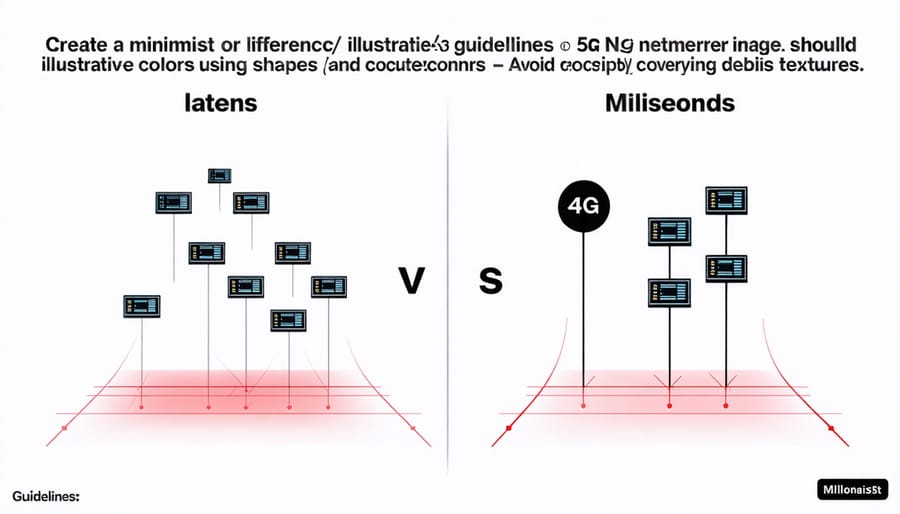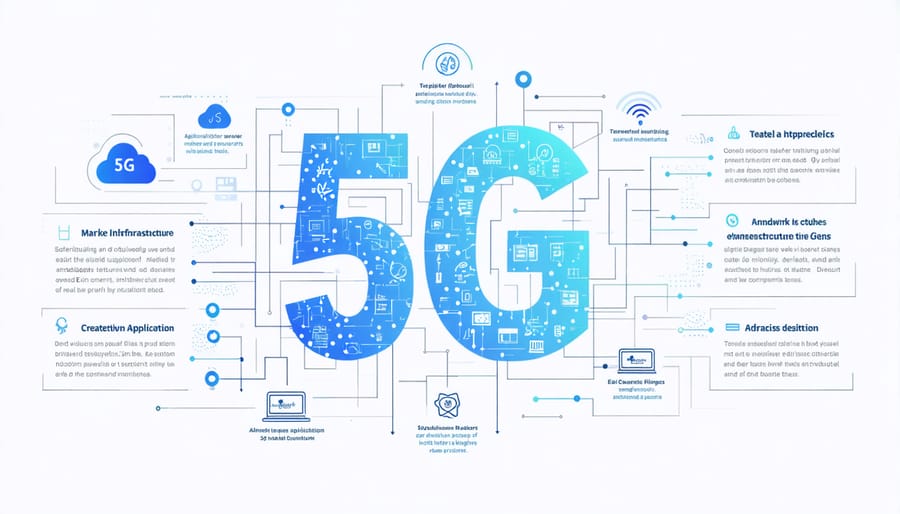How 5G’s Ultra-Low Latency Is Revolutionizing Real-Time Marketing

5G’s ultra-low latency is transforming how businesses connect with customers, enabling split-second interactions that were previously impossible. At just 1 millisecond – compared to 4G’s 20-50 milliseconds – this breakthrough in network responsiveness powers everything from instant mobile transactions to seamless augmented reality experiences. For marketing professionals and business leaders, this technological leap enables real-time marketing adaptations that respond to consumer behavior as it happens. By eliminating the delay between action and reaction, 5G’s near-instantaneous communication is creating unprecedented opportunities for personalized customer engagement, interactive advertising, and data-driven decision making. Understanding how to leverage this technology isn’t just about staying competitive – it’s about reimagining what’s possible in modern marketing.
Understanding 5G Latency in Marketing Context
From 4G to 5G: The Latency Leap
The leap from 4G to 5G represents a dramatic improvement in latency performance, with 4G networks typically operating at 50-100 milliseconds while 5G can achieve speeds as low as 1 millisecond. For marketers, this difference transforms how brands can interact with their audiences in real-time.
Consider a retail app: With 4G, there’s a noticeable delay between a customer’s action and the app’s response. Under 5G, these interactions become instantaneous, enabling seamless product browsing, instant price comparisons, and real-time inventory updates. This responsiveness is particularly crucial for location-based marketing, augmented reality experiences, and interactive advertising campaigns.
The reduced latency also enables more sophisticated marketing automation. Businesses can now deliver personalized content, process customer interactions, and adjust marketing strategies in real-time without the lag that previously hampered customer engagement. This advancement makes emerging technologies like virtual showrooms and interactive product demonstrations truly practical for everyday marketing use.

Why Milliseconds Matter in Modern Marketing
In today’s digital marketplace, customer attention spans are shorter than ever. Even a one-second delay in website loading or ad display can result in a 7% reduction in conversions. With 5G’s ultra-low latency, marketers can now deliver instant, seamless experiences that capture and maintain customer attention.
Real-time personalization becomes truly real-time, allowing marketing systems to adjust content, offers, and messaging based on immediate customer behavior. Interactive advertisements, augmented reality experiences, and location-based promotions can respond instantly to customer interactions, significantly improving engagement rates.
For e-commerce businesses, this means shopping cart abandonment rates can be reduced through instantaneous page loads and checkout processes. Video advertising becomes more effective with zero buffering, and virtual try-on features work flawlessly. These millisecond improvements translate into tangible benefits: higher conversion rates, increased customer satisfaction, and ultimately, better ROI on marketing investments.
Real-Time Marketing Opportunities with 5G
Instant Interactive Experiences
5G’s ultra-low latency is revolutionizing how businesses engage with customers through immersive technologies. With response times of just 1-2 milliseconds, companies can now deliver seamless AR customer experiences and virtual reality applications that respond in real-time to user interactions.
This breakthrough enables businesses to create truly interactive virtual showrooms where customers can examine products from every angle, customize features instantly, and make informed purchasing decisions. Retail stores can implement virtual try-on solutions that work flawlessly, while real estate agencies can offer virtual property tours that feel as natural as walking through an actual home.
The impact extends beyond retail applications. Customer service teams can utilize holographic representations for face-to-face interactions, making remote support feel personal and immediate. Training and educational programs benefit from real-time feedback systems, allowing instructors to guide students through complex procedures without frustrating delays.
For marketing professionals, this means the ability to create engaging campaigns that respond to customer behavior instantaneously. Interactive billboards can adjust content based on viewer engagement, while mobile AR applications can deliver personalized promotional content without lag. These capabilities open new avenues for customer engagement, making brand interactions more memorable and effective.
The key to success lies in developing content that takes full advantage of 5G’s minimal latency while ensuring these experiences remain accessible and valuable to your target audience.

Live Event Marketing Enhancement
The integration of 5G technology is revolutionizing live event marketing by enabling unprecedented levels of audience engagement and interactive experiences. With ultra-low latency, marketers can now deliver real-time, personalized content to event attendees without the frustrating delays that previously hindered engagement.
Event organizers can implement instant polling, live voting, and interactive displays that respond immediately to audience participation. This real-time feedback loop creates more dynamic and engaging experiences, leading to higher attendee satisfaction and increased brand engagement. For instance, concert-goers can now vote on encore songs or participate in live AR experiences without lag, while sports fans can access instant replays and statistics on their mobile devices.
The enhanced bandwidth and reduced latency of 5G also enable seamless livestreaming of events to virtual attendees, creating hybrid experiences that expand reach and revenue potential. Marketers can now offer virtual reality tours, 360-degree views, and multi-angle camera feeds that switch instantly based on viewer preferences.
For exhibitors and sponsors, 5G enables sophisticated lead capture systems and location-based marketing initiatives that trigger relevant content delivery as attendees move through event spaces. Real-time analytics provide immediate insights into audience behavior and engagement levels, allowing marketers to adjust their strategies on the fly for maximum impact.
This technological advancement has particularly transformed mobile marketing at events, enabling instant downloads of promotional materials, seamless mobile payment processing, and interactive product demonstrations that respond in real-time to user input.
Implementing 5G-Ready Marketing Strategies

Technical Requirements and Setup
To implement 5G low-latency capabilities, businesses need to ensure their infrastructure meets specific technical requirements. First, you’ll need 5G-compatible devices and equipment, including smartphones, IoT sensors, and network adapters that support the latest 5G standards. Your location should have access to 5G coverage, preferably with mmWave capabilities for optimal performance.
Network infrastructure upgrades may be necessary, including the installation of small cell towers and fiber-optic connections. Work with your telecom provider to assess coverage needs and potential infrastructure improvements. For indoor spaces, consider implementing distributed antenna systems (DAS) to ensure consistent signal strength.
Your backend systems should be optimized for real-time customer interaction and data processing. This includes updating servers, implementing edge computing solutions, and ensuring your software applications can handle high-speed data transmission.
Security measures must be enhanced to protect the increased data flow. Install updated firewalls, implement encryption protocols, and establish monitoring systems for network performance. Regular testing and maintenance schedules should be established to maintain optimal performance levels.
Consider working with IT consultants who specialize in 5G implementation to ensure proper setup and integration with existing systems. They can help create a deployment roadmap that aligns with your business objectives while minimizing disruption to ongoing operations.
Campaign Optimization for 5G
To optimize marketing campaigns for 5G environments, focus on leveraging the technology’s ultra-low latency capabilities. Start by redesigning your ad creatives to include more interactive and dynamic elements that previously weren’t feasible due to latency constraints. Consider implementing real-time personalization that responds instantly to user behaviors and preferences.
Location-based marketing takes on new significance with 5G. Deploy geo-targeted campaigns that activate immediately when customers enter specific areas, without the delay typical of older networks. This enables truly contextual advertising that feels natural and timely to consumers.
Video advertising should be reimagined for 5G capabilities. Incorporate high-definition, interactive video content that loads instantly and responds to user interactions in real-time. Consider implementing 360-degree videos, augmented reality elements, and live streaming features in your campaigns.
Test your campaigns across different 5G networks and devices to ensure consistent performance. Monitor key metrics like load times, interaction rates, and conversion speeds to optimize campaign effectiveness. Set up A/B tests comparing traditional formats against 5G-optimized versions to measure performance improvements.
Remember to maintain fallback options for users still on 4G networks. Design your campaigns with progressive enhancement in mind, where basic functionality works for all users while additional features automatically activate for those with 5G capability. This ensures a smooth experience across your entire audience while maximizing the benefits of 5G technology.
5G’s ultra-low latency is revolutionizing how businesses connect with their customers and optimize their operations. As we’ve explored, the millisecond-level responsiveness enables real-time interactions, enhanced mobile experiences, and innovative marketing possibilities that were previously impossible. For businesses, this means more engaging customer experiences, improved data analytics, and streamlined operations across multiple locations.
Looking ahead, the continued rollout of 5G infrastructure will create even more opportunities for business growth and innovation. We can expect to see new applications in augmented reality marketing, instant customer service solutions, and seamless multi-device experiences. Companies that begin adapting their strategies now will be better positioned to leverage these advantages as the technology matures.
To stay competitive, businesses should start by assessing their current digital infrastructure and identifying areas where low latency could provide the most significant impact. Whether it’s improving mobile app performance, enabling real-time customer interactions, or developing new marketing experiences, the time to prepare for the 5G future is now. The businesses that embrace these changes early will gain a significant advantage in an increasingly connected marketplace.
Leave a Reply